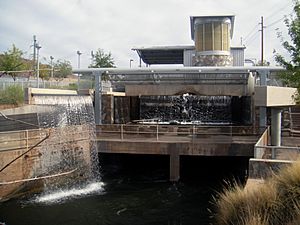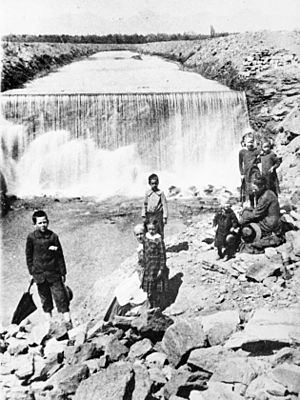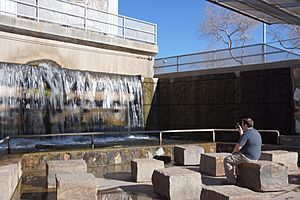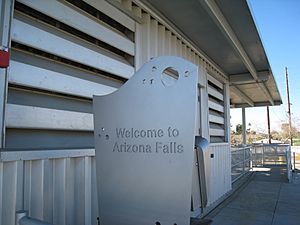Arizona Falls facts for kids
Quick facts for kids Arizona Falls |
|
|---|---|
| G.R. Herberger Park | |
 |
|
| Location | 5802 E Indian School Rd, Phoenix, Arizona, U.S. |
| Open | 24 hours (parking open 5am-10pm) |
| Purpose | Power |
| Status | Operational |
| Construction began | 1901 |
| Opening date | 1903, rebuilt 2003 |
| Owner(s) | Salt River Project |
| Dam and spillways | |
| Impounds | Arizona Canal |
| Height (thalweg) | 20 ft (6.1 m) |
| Power station | |
| Commission date | 2003 |
| Type | Conventional |
| Installed capacity | 0.750 |
Arizona Falls is a cool waterfall and park located in Phoenix, Arizona, USA. It was created when the man-made Arizona Canal flowed over a natural drop in the land. This spot became a popular place for people to gather and have fun.
Later, it was used as a hydroelectric power station. This plant helped provide the first electricity to Phoenix! After working for 50 years, the area became run down. With new inventions like air conditioning, the falls weren't as popular for cooling off.
In the early 2000s, Arizona Falls was rebuilt. It became both a public art project and a working power station again. Today, it makes enough electricity to power about 150 homes. It's also a great spot for walkers, joggers, and cyclists. The modern park officially opened in 2003.
Contents
History of Arizona Falls
The story of Arizona Falls begins with a builder named William J. Murphy. He was in charge of building the Arizona Canal. This canal was designed to bring water from the Salt River to help farms grow crops in the Valley of the Sun.
Work on the canal started in 1883. In 1884, the builders reached a hard rock area. Instead of removing the rock, they decided to let the canal water flow over it. This is how the man-made waterfall was created!
The waterfall quickly became a popular place. It was like a cool oasis in the hot desert. The mist from the falling water helped lower the air temperature. Trees also provided shade. People from Phoenix and Tempe, which were about 6 to 7 miles away, would visit for picnics and other fun activities. Even visitors to the Valley were often taken there to see the sight. The area around the falls became known as Arizona Falls.
By 1892, there was a plan to build a railway from Phoenix to Arizona Falls. This railway would use electric trains powered by electricity from the falls! Major investors from Phoenix, San Francisco, and Hamilton, Ohio were interested. Around the same time, a town called Ingleside was being developed near the falls. The first large citrus orchards were also planted there. A mill was also built at the falls.
Electric Power Plant at the Falls

The very first power plant at Arizona Falls was built in 1901-1902. It was built by the Phoenix Light and Fuel Company. This company later became Arizona Public Service. The plant's job was to provide electricity to the city of Phoenix.
By 1909, the engineers from the Salt River Project (SRP) decided to take over the power station. SRP manages the canal system. They wanted to upgrade the equipment to make even more power. The plant was completely rebuilt starting in 1911.
New, powerful turbines were ordered from a company in Pennsylvania. Large generators were bought from General Electric. Other important equipment came from Westinghouse Electric. These generators were some of the biggest machines ever brought to the Phoenix area at that time!
The powerhouse building was about 40 feet by 40 feet. It had special concrete channels to direct water. When the turbines weren't running, a "wasteway" sent water back into the canal. A "spillway" returned water to the canal after it went through the turbines. A small four-room house was also built for the plant's operator. Construction finished in the spring of 1913.
After the power plant was built, it actually covered up the original falls. But the roof of the plant became a dance floor! Guests from the nearby Ingleside Inn, which was the Valley's first resort, would often come to dance there. The resort was built by William Murphy, who thought the falls would attract people.
In 1914-1915, a group of farmers formed a cooperative called "Falls Power & Electric Co." They bought power from the Arizona Falls plant for their farms. Later, in 1918, the Scottsdale Light and Power Co. was formed. They bought power from the falls to supply Scottsdale, which was about 3 miles east. This company eventually joined with APS in 1940.
The power plant was shut down on October 2, 1950. It had become too expensive to keep running and needed many repairs. After it closed, the canal water still flowed through the old structure. The falls remained hidden from public view for many years.
Rebuilding Arizona Falls
About 25 years later, SRP started thinking about building a new small hydroelectric plant at the falls. By 1980, with rising oil prices, it made sense to build an 850 kilowatt plant. In the early 1990s, people also started wanting to use the canal system for fun and community benefit.
The idea to turn the site into a park was first suggested in 1998. SRP decided to rebuild the power station at the same time as the park project. The power station rebuild cost $4 million. It was the largest renewable energy plant SRP had in the Valley at that time.
Today, depending on how much water is flowing, the falls can generate up to 750 kilowatts of electricity. Solar panels on the plant's roof also add to the power. All this electricity goes into SRP's power grid. The new power station started working in April 2003.
Art and Design at the Park
The City of Phoenix helped fund the design and restoration of the falls. The park was designed by architect Lajos Heder and sculptor Mags Harries from Boston. They were chosen in 2000 after a competition. The landscape architect was Steve Martino.
The park includes some of the original, rusty gears from the old power station. Signs tell visitors about the history and design of the plant. You can even walk across the canal on a footbridge! The park also features a large rock from each of the five major dams on the Salt River that store water for the SRP system.
The park is mostly made of concrete, stone, and steel. It cost over $2 million in 2003. Funding came from the City of Phoenix and the US Bureau of Reclamation.
Underneath a deck called the "Stoa Deck" (which means "gathering place" in Greek), concrete channels guide the canal water into the power station's turbines. A smaller amount of water is sent to the park's waterfall features. These include two 20-foot waterfalls and a 10-foot water wall that surround a viewing platform.
Poems about water, written by Arizona's first state poet laureate, Alberto Rios, are carved into the concrete. The City of Phoenix maintains the park, as well as the nearby G.R. Herberger Park, where visitors can park. The site reopened to the public on June 21, 2003.
The Arizona Falls project also included improvements to Indian School Road. The canal banks, which used to be plain concrete, were hidden with decorative walls and landscaping.
The project won a top award from Valley Forward in 2003 for improving the environment and quality of life in Phoenix. The Arizona Republic newspaper named it "Best Public Art" for 2003. In 2004, it was even a finalist to become a "Phoenix Point of Pride."
Learning at Arizona Falls
SRP encourages teachers to use Arizona Falls as a place to learn. Schools can teach students about renewable energy and other environmental topics related to the site and the canal system. SRP even provides lesson plans for teachers!



